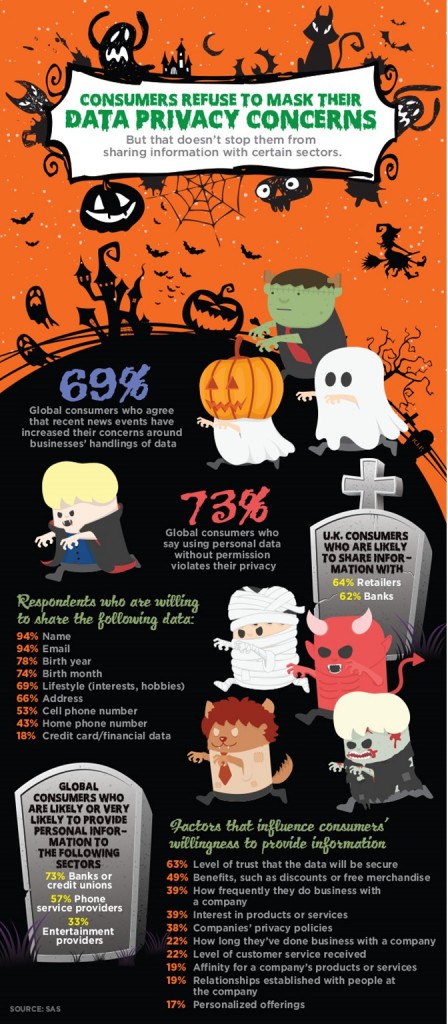Marketers are walking a tightrope today with data privacy issues: Data can simultaneously bring customers and brands together and further drive them apart.
Recent data breaches, potential changes in data-privacy legislation and regulations loom large as customer expectations concerning marketing data continue to rise. As a result, today’s complex data issues are becoming a more like a horror flick. The outcome of these discussions, customer expectations, data-security lapses and rules-making efforts could change everything.

Amidst this backdrop, SAS conducted a global study on how consumers balance their need for privacy and personalization: Finding the Right Balance Between Personalization and Privacy.
Some of the findings are appropriately depicted in the chilling infographic to the right, created and originally published by DM News and included here with permission.
What is scary?
The complexity and fragmentation of the customer journey due to the explosion of digital channels, platforms, data and content has placed enormous strain on marketing to be contextually and personally relevant and responsive. Data privacy slips can easily obliterate brand choice.
Also, when different source systems capture the same customer information, it is seldom consistent. And inconsistency can lead to errors, which often results in angst due to privacy violations, plus unnecessary costs. To minimize the horror, technologies such as Master Data Management can take charge of key information assets – defining a “master hub” of core information that references the same key asset by all users and systems.
In this regard, the biggest complaint about data privacy that we hear from marketers is that the maze of privacy laws from various industry bodies and government agencies are often cryptic and sometimes in conflict with each other. The lack of harmonization within and across countries remains a source of dread, confusion and annoyance for most businesses.
For example, in the US, 47 states have attempted to legislate privacy in one way or another. Unlike the European Union, there is no overarching law at the EU level that sets a minimum standard for privacy. Every member country has its own laws. As a result, if you do marketing in the EU, you must deal with the privacy laws of 28 member states.
Scary, yes?
What’s not as scary?
Despite concerns over privacy, consumers are still willing to trade privacy for personalization. Our study found 69 percent of those surveyed said recent news—NSA leaks, social media privacy changes, data breaches, etc.—increased their privacy concerns. Yet, consumers are still willing to trade privacy for personalization. Our study showed that 57 percent still expect businesses to know their preferences and understand their needs.
In exchange for consumers' trust, brands must offer the following in every interaction: relevance, value and control. Consumers show trust by providing customer information in exchange. Brands can also assure customers that their data is managed well and give customers options to decide how their personal information is used.Consumers are okay with giving up some of their personal information for greater personalization--as long as they get to make that choice themselves.
For more helpful insights and take-always, I suggest reading Finding the Right Balance Between Personalization and Privacy in its entirety—preferably in a well-lit room.
2 Comments
Interesting study results - finding consumers are still willing to trade privacy for personalization. Is it that they perceive a greater reward to do so or they're not fully aware of the risks? The choice becomes a decision to protect privacy or receive personalization. Can you get personalization without divulging specific information about yourself?
Hi Michele! You raise an interesting point.
You can personalize experiences without getting too personal. Analytics certainly helps in that arena. Here's the most important thing: use the information wisely, showing respect and restraint for the customers’ data. You can introduce personalization through customer data--no matter how limited--in small but meaningful ways, and build upon your customers’ trust, comfort levels and expectations over time.
Thanks for comment!